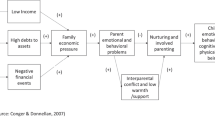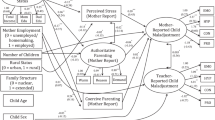Summary
The Home Observation for Measurement of the Environment (HOME) scale has been shown to be a significant predictor of later cognitive outcomes in many cultures. Therefore identifying factors associated with HOME could be used to promote child development. Maternal psychological well-being is often overlooked although critical in the creation of quality in the home environment. This study examined associations between maternal well-being and HOME using a data set of South Indian rural mothers and infants to test the hypothesis that mothers with internal Locus of Control (LOC) and higher self-esteem (SE) will have a more stimulating home environment than mothers with an external LOC and lower SE, controlling maternal education, depression and SES as potential confounders. Results indicated significant association between maternal SE and LOC and HOME even after controlling for SES and maternal education. The paper examines factors associated with maternal LOC and SE, and argues that programs and policies must consider maternal well-being in interventions for improving child development.
Résumé
La balance d’HOME (foyer, en français) s’est avéré un facteur prédictif significatif des résultats cognitifs postérieurs dans beaucoup de cultures. Par conséquent l’identification des facteurs liés à l’HOME pourrait être employée pour favoriser le développement d’enfant. Le bien-être psychologique maternel est souvent négligé bien que critique dans la création de la qualité dans l’environnement familial. Cette étude a examiné des associations entre le.bien-être et l’HOME maternels utilisant un ensemble de données sur des mères et enfants rurales du sud de l’Inde pour évaluer l’hypothèse qui des mères avec le lieu interne de la commande (LOC) et un amour-propre plus élevé (SE) auront un environnement familial plus stimulant que des mères avec un LOC externe et un SE plus bas, et contrôle de leur éducation maternelle, dépression et SES en tant qu’ éléments potentiels de confusion. Les résultats ont indiqué l’association significative, entre le SE et le LOC maternels et l’HOME même après le contrôle du SES et de l’éducation maternelle. Le papier examine des facteurs liés au LOC et SE maternels, et argue du fait que les programmes et les politiques doivent considérer le bien-être maternel dans les interventions pour améliorer le développement d’enfant.
Resumen
La autoestima materna y el locus de control se relacionan con la calidad del medio ambiente del niño (HOGAR) en el área rural Andhra Pradesh, India: investigación e implicancias de la politica. La escala Hogar ha probado ser un predictor significativo de resultados cognitivos posteriores en muchas culturas. Por lo tanto, el identificar factores asociados con HOGAR podría ser usado para promover el desarrollo infantil. El bienestar psicológico materno es generalmente subvalorado aunque es crítico en la creación de la calidad del ambiente hogareño. Este estudio examinó las asociaciones entre el bienestar materno y el HOGAR utilizando un conjunto de datos de madres de áreas rurales del sur de India e infantes para probar la hipótesis de que las madres con locus de control interno (LOC) y alta autoestima (SE) tendrán un ambiente hogareño más estimulante que las madres con un LOC externo y baja SE, controlando la educación materna, la depresión y nivel socioeconómico (SES) como variables intervinientes potenciales. Los resultados indicaron asociaciones significativas entre la SE materna y LOC con los resultados de la pauta HOGAR incluso después de controlar la SES y la educación materna. El articulo examina los factores asociados con LOC y SE materno, y postula que los programas y las politicas deben considerar el bienestar materno en las intervenciones para mejorar el desarrollo infantil.
Similar content being viewed by others
References
Alpern, L., & Lyons-Ruth, K. (1993). Preschool children at social risk: Chronicity and timing of maternal depression symptoms at school and at home.Development and Psychopathology, 5, 371–387.
Baumeister, R.F. (1999).The Self in Social Psychology. Philadelphia, PA: Psychology Press Taylor & Francis.
Black, M.M., Baqui, A.H., Zaman, K., McNary S.W., Le, K., El Arifeen, S., Hamadani, J.D., Parveen, M., Yunus, M., & Black, R.E. (2007). Depressive symptoms among rural Bangladeshi mothers: Implications for infant development.Journal of Child Psychology and Psychiatry, 48(8), 764–772.
Bradley, R.H., & Corwyn, R.F. (2005). Caring for children around the world: A view from HOME.International Journal of Behavioral Development, 29(6), 468–478.
Bradley R., Corwyn R., & Whiteside-Mansell L. (1996). Life at home: same time, different places — an examination of the HOME Inventory in different culture.Early Dev Parenting, 6, 1–19
Brennan, P.A., Hammen, C., Anderson, M.J., Bor, W., Najman, J.M. & Williams, G.M. (2000). Chronicity, severity, and timing of maternal depressive symptoms: Relationships with child outcomes at age 5.Developmental Psychology, 36, 759–766.
Caldwell, B. & Bradley, R. (1984). The HOME Inventory and family demographics.Developmental Psychology, 20, 315–320.
Campbell, S.B., Cohn, J.F., & Meyers, T. (1995). Depression in first time mothers: Mother-infant interaction and depression chronicity.Developmental Psychology, 31, 349–357.
Cravioto, J., & DeLicardie, E.R. (1976)Micro-environmental factors in severe protein-calorie malnutrition. Nutrition and Agricultural Development: Significance and Potential for the Tropics. New York: Plenum Press.
Engelke, M.K., & Engelke, S.C. (1992). Predictors of the Home Environment of High Risk Infants.Journal of Community Health Nursing, 9, 171–181.
England, S.J., Ballard, C., & Shoba, G. (1994). Chronicity in postnatal depression.European Journal of Psychiatry, 8, 93–96.
Engle, P., Menon, & Haddad, L. (1996).Care: Concepts and measurements. Food Consumption and Nutrition Division Discussion Paper, 18. International Food Policy Research Institute, Washington, D.C. Mimeo.
Galab, S., M. Gopinath Reddy, P. Anthony, A. McCoy, C Ravi, D Sreerama Raju, K Mayuri, & P. Prudhivikar Reddy. (2003).Young Lives Preliminary Country Report: Andhra Pradesh, India. London: Save the Children UK.
Hay D.F., Pawlby, S., Sharp, D., Asten, P., Mills, A., & Kumar, R. (2001). Intellectual problems shown by 11-year-old children whose mothers had postnatal depression.Journal of Child Psychology & Psychiatry, 42, 871–89.
International Institute for Population Sciences (2007).National Family Health Survey-3. Mumbai India: IIPS.
Junko, S., Kazunori, K., Katsuaki, S., Shigeko, K., Ayako (2002).The Reliability and Validity of the Rosenberg Self-Esteem Scale with Japanese Patients after Stroke. Memoirs of Kyushu University, School of Health Sciences, 29, 87–96.
Kumar, S.P.B., & Thomas, I. (1992).I.E. Scale. Department of Psychology, University of Kerala, India.
Luoma, I., Tamminen, T., Kaukonen, P., Laippala, P., Puura, K., Salmelin, R., et al. (2001). Longitudinal study of maternal depressive symptoms and child well-being.Journal of the American Academy of Child and Adolescent Psychiatry, 40, 1367–1374.
Mann, M., Hosman, C., Schaalma H.K., & de Vries, N. (2004). Self-esteem in a broad spectrum approach for mental health.Health Education Research, 4, 1093.
Mohite, K. (1992).Indian Adaptation of the HOME Scale. New Delhi, India: University of Delhi Library.
Muñoz, Vázquez, Fernando L, Ricardo F., Blanco, Vanessa, López, María. (2008). Validation of Muñoz’s Mood Screener in a nonclinical Spanish population.European Journal of Psychological Assessment, 24, 57–64.
Murray, L. (1992). The impact of postnatal depression on infant development,Journal of Child Psychology & Psychiatry, 33, 543–61.
Murray, L., Stanley, C., Hooper, R., King, F., & Fiori-Cowley, A. (1996). The role of infant factors in postnatal depression and mother-infant interactions.Dev Med Child Neurology, 38, 109–119.
Patel, V., Rahman, A., Jacob, K., & Hughes, M. (2004). Effect of maternal mental health on infant growth in low income countries: new evidence from South Asia.British Medical Journal, 328, 820–823.
Petterson, S.M., & Albers, A.B. (2001). Effects of povery and maternal depression on early child development.Child Development, 72 1794–1813.
Radloff, L.S. (1977). The CES-D scale: a self report depression scale for research in general population.Applied Psychological measurement, 1, 385–401.
Rahman A. Bunn J., Lovel H. & Creed F. (2007a) Association between antenatal depression and low birth weight in a developing country.Acta Psychiatrica Scandinavica. 115(6), 481–6.
Rahman, A., Bunn, J., Lovel, H., & Creed, F. (2007b). Maternal depression increases infant risk of diarrhoeal illness:-a cohort study.Archives of Disease in Childhood, 92, 24–28
Rahman, A., Harrington, R. & Bunn, J. (2002) Can maternal depression increase infant risk of, illness and growth impairment in developing countries?Child: Care, Health and Development, 28, 51–56.
Rahman, A., Iqbal, Z., Bunn, J., Lovel, H., & Harrington, R. (2004). Impact of maternal depression on infant nutritional status and illness: a cohort study.Archives of General Psychiatry, 61, 946–952.
Rahman, A., Iqbal, Z., Bunn, J., Lovel, H., & Harrington, R. (2004a). Impact of maternal depression on infant nutritional status and illness.Archives of General Psychiatry, 61, 946–952.
Rahman, A., Lovel, H., Bunn, J., Iqbal, Z., & Harrington, R. (2004b). Mothers’ mental health and infant growth: a case-control study from Rawalpindi, Pakistan.Child: Care, Health and Development, 30, 21–27.
Ramalingaswami, V., Jonsson, U., & Rohde, J. (1996).The Asian enigma. UNICEF The Progress of Nations, 1966, 10–17.
Rosenberg, M. (1989).Society and the adolescent self-image. Revised edition. Middletown, CT: Wesleyan University Press.
Rotter, J.B., (1966). Generalized expectancies for internal versus external control of reinforcement.Psychology Monograph, 80, 1–28.
Schaefer, E.S., & Others. (1983).Childrearing and child development correlates of maternal locus of control. Paper presented at the Annual Convention of the American Psychological Association, 91st, Anaheim, CA, August 26–30, 1983.
Schmitt, D.P., & Allik, J. (2005). Simultaneous administration of the Rosenberg Self-Esteem scale in 53 nations: Exploring the universal and culture-specific features of global self-esteem.Journal of Personality and Social Psychology, 89, 623–642.
Sharp, D., Hay, D.F., Pawlby, S., Schmücker, G., Allen, H., & Kumar, R. (1995). The impact of postnatal depression on boys’ intellectual development.Journal of Child Psychology & Psychiatry, 36, 1315–1336.
Shonkoff, J., & Phillips, DA. (2000).From neurons to neighborhoods. Washington, DC: National, Academies Press.
Shroff, M., Bentley, M., Balakrishna Nagalla, B., Chirayath Suchindran, C., Griffiths, P., & Vazir, S. (2008).Maternal autonomy is an independent predictor of feeding practices and growth in rural Indian infants. FASEB J, 21, 239.5.
Wachs, T.D., Black, M.M., & Engle, P.L. (in press). Maternal depression: A global threat to children’s health, development and behavior and to human rights.Child Development Perspectires.
Author information
Authors and Affiliations
Corresponding author
Additional information
An erratum to this article is available at http://dx.doi.org/10.1007/BF03168487.
Rights and permissions
About this article
Cite this article
Fernandez, S., Vazir, S., Bentley, P. et al. Maternal self esteem and Locus of Controlrelates to the quiality of young children’s environment (HOME) in Rural Andhra Pradesh, India: Research and policy implications. IJEC 40, 85–99 (2008). https://doi.org/10.1007/BF03165841
Issue Date:
DOI: https://doi.org/10.1007/BF03165841




